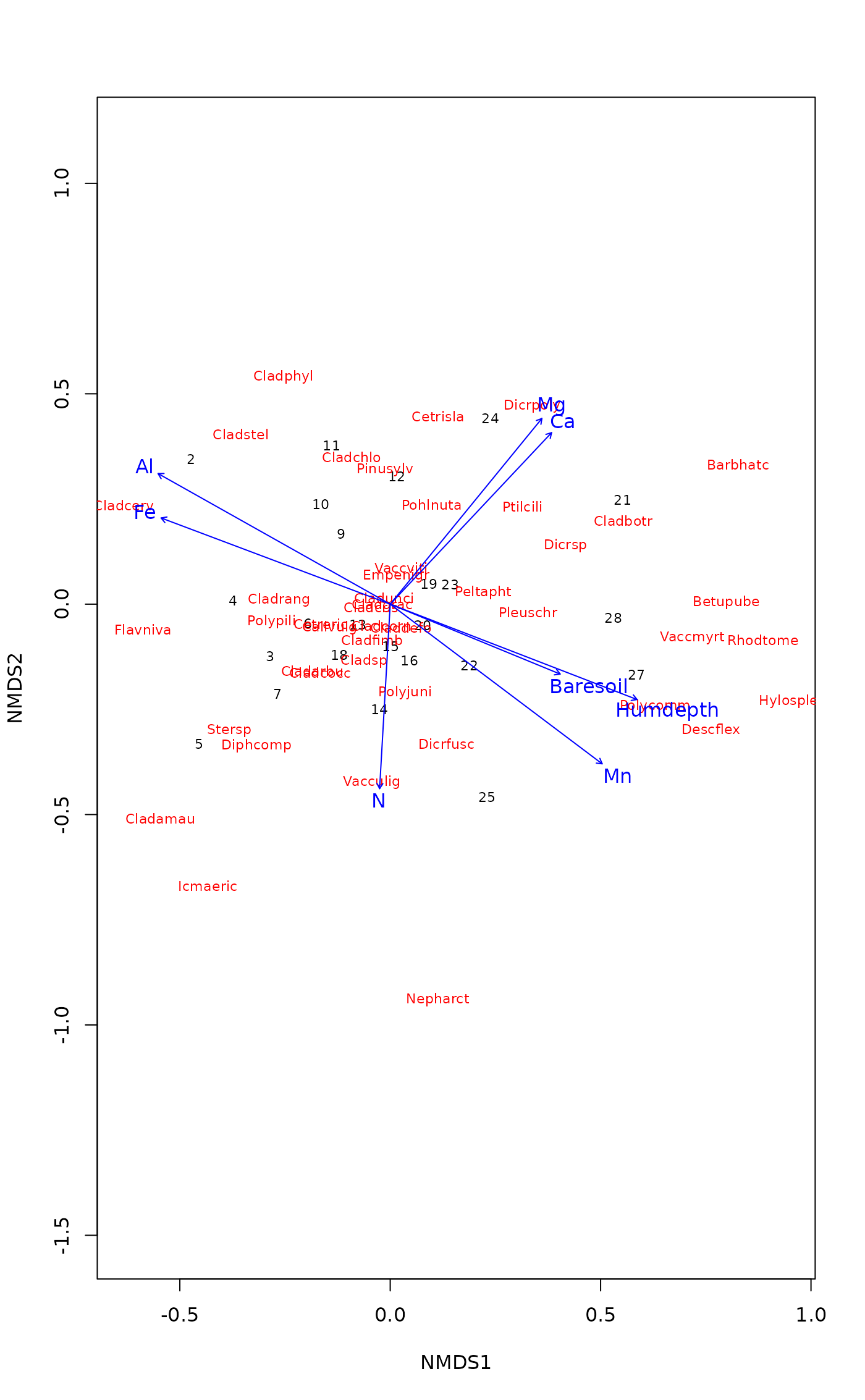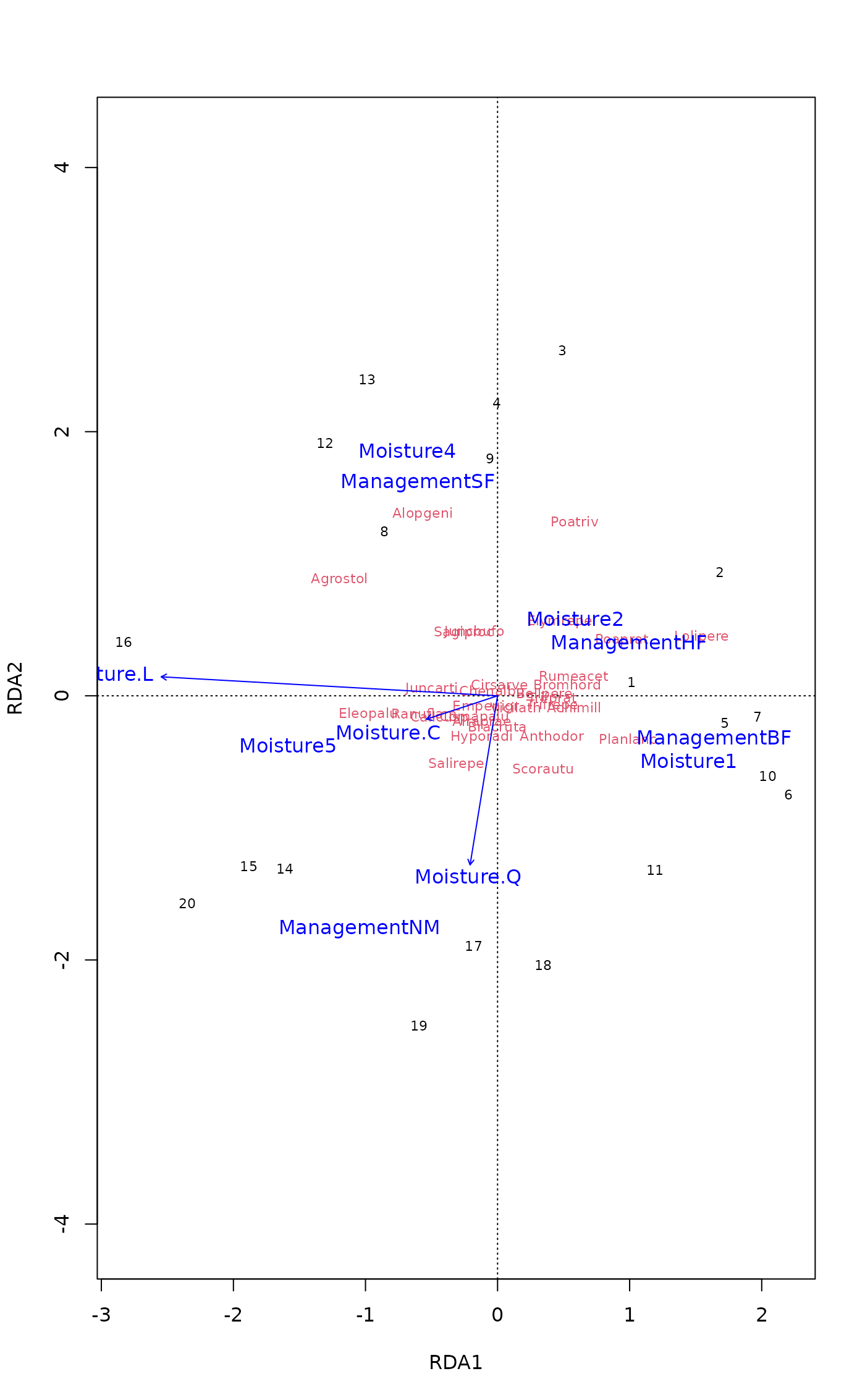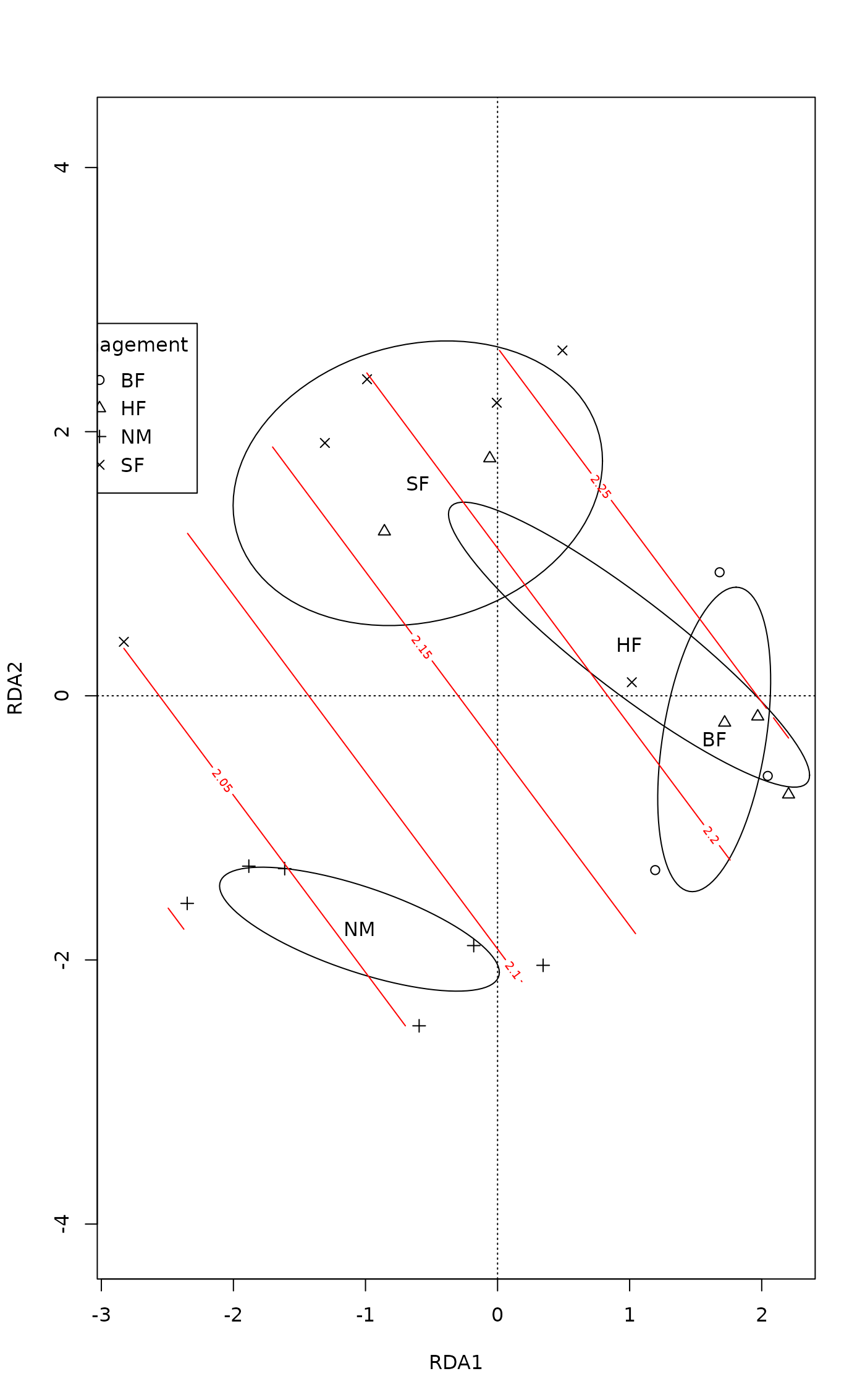Community Ecology Package: Ordination, Diversity and Dissimilarities
vegan-package.RdThe vegan package provides tools for descriptive community ecology. It has most basic functions of diversity analysis, community ordination and dissimilarity analysis. Most of its multivariate tools can be used for other data types as well.
Details
The functions in the vegan package contain tools for diversity analysis, ordination methods and tools for the analysis of dissimilarities. Together with the labdsv package, the vegan package provides most standard tools of descriptive community analysis. Package ade4 provides an alternative comprehensive package, and several other packages complement vegan and provide tools for deeper analysis in specific fields. Package BiodiversityR provides a GUI for a large subset of vegan functionality.
The vegan package is developed at GitHub (https://github.com/vegandevs/vegan/). GitHub provides up-to-date information and forums for bug reports.
Most important changes in vegan documents can be read with
news(package="vegan") and vignettes can be browsed with
browseVignettes("vegan"). The vignettes include a vegan
FAQ, discussion on design decisions, short introduction to ordination
and discussion on diversity methods.
To see the preferable citation of the package, type
citation("vegan").
Author
The vegan development team is Jari Oksanen, F. Guillaume Blanchet, Roeland Kindt, Pierre Legendre, Peter R. Minchin, R. B. O'Hara, Gavin L. Simpson, Peter Solymos, M. Henry H. Stevens, Helene Wagner. Many other people have contributed to individual functions: see credits in function help pages.
Examples
### Example 1: Unconstrained ordination
## NMDS
data(varespec, varechem)
ord <- metaMDS(varespec)
#> Square root transformation
#> Wisconsin double standardization
#> Run 0 stress 0.1843196
#> Run 1 stress 0.2067744
#> Run 2 stress 0.1976151
#> Run 3 stress 0.2444586
#> Run 4 stress 0.2095882
#> Run 5 stress 0.233192
#> Run 6 stress 0.1825658
#> ... New best solution
#> ... Procrustes: rmse 0.04162469 max resid 0.1517992
#> Run 7 stress 0.2295042
#> Run 8 stress 0.2092456
#> Run 9 stress 0.1825658
#> ... Procrustes: rmse 3.746352e-06 max resid 1.292456e-05
#> ... Similar to previous best
#> Run 10 stress 0.2092456
#> Run 11 stress 0.2290222
#> Run 12 stress 0.237339
#> Run 13 stress 0.1869637
#> Run 14 stress 0.2807394
#> Run 15 stress 0.1955836
#> Run 16 stress 0.1969805
#> Run 17 stress 0.2066027
#> Run 18 stress 0.2088293
#> Run 19 stress 0.1869637
#> Run 20 stress 0.1948413
#> *** Best solution repeated 1 times
plot(ord, optimize = TRUE, type = "t")
## Fit environmental variables
ef <- envfit(ord, varechem)
ef
#>
#> ***VECTORS
#>
#> NMDS1 NMDS2 r2 Pr(>r)
#> N -0.05730 -0.99836 0.2536 0.042 *
#> P 0.61972 0.78482 0.1938 0.111
#> K 0.76645 0.64230 0.1809 0.139
#> Ca 0.68519 0.72836 0.4119 0.004 **
#> Mg 0.63252 0.77455 0.4270 0.003 **
#> S 0.19138 0.98152 0.1752 0.124
#> Al -0.87160 0.49021 0.5269 0.001 ***
#> Fe -0.93602 0.35194 0.4450 0.005 **
#> Mn 0.79871 -0.60172 0.5231 0.001 ***
#> Zn 0.61755 0.78653 0.1879 0.106
#> Mo -0.90308 0.42948 0.0609 0.511
#> Baresoil 0.92489 -0.38024 0.2508 0.044 *
#> Humdepth 0.93283 -0.36032 0.5200 0.001 ***
#> pH -0.64798 0.76166 0.2308 0.069 .
#> ---
#> Signif. codes: 0 ‘***’ 0.001 ‘**’ 0.01 ‘*’ 0.05 ‘.’ 0.1 ‘ ’ 1
#> Permutation: free
#> Number of permutations: 999
#>
#>
plot(ef, p.max = 0.05)
 ### Example 2: Constrained ordination (RDA)
## The example uses formula interface to define the model
data(dune, dune.env)
## No constraints: PCA
mod0 <- rda(dune ~ 1, dune.env)
mod0
#>
#> Call: rda(formula = dune ~ 1, data = dune.env)
#>
#> Inertia Rank
#> Total 84.12
#> Unconstrained 84.12 19
#>
#> Inertia is variance
#>
#> Eigenvalues for unconstrained axes:
#> PC1 PC2 PC3 PC4 PC5 PC6 PC7 PC8
#> 24.795 18.147 7.629 7.153 5.695 4.333 3.199 2.782
#> (Showing 8 of 19 unconstrained eigenvalues)
#>
plot(mod0, spe.par = list(arrows = TRUE))
### Example 2: Constrained ordination (RDA)
## The example uses formula interface to define the model
data(dune, dune.env)
## No constraints: PCA
mod0 <- rda(dune ~ 1, dune.env)
mod0
#>
#> Call: rda(formula = dune ~ 1, data = dune.env)
#>
#> Inertia Rank
#> Total 84.12
#> Unconstrained 84.12 19
#>
#> Inertia is variance
#>
#> Eigenvalues for unconstrained axes:
#> PC1 PC2 PC3 PC4 PC5 PC6 PC7 PC8
#> 24.795 18.147 7.629 7.153 5.695 4.333 3.199 2.782
#> (Showing 8 of 19 unconstrained eigenvalues)
#>
plot(mod0, spe.par = list(arrows = TRUE))
 ## All environmental variables: Full model
mod1 <- rda(dune ~ ., dune.env)
#>
#> Some constraints or conditions were aliased because they were redundant. This
#> can happen if terms are constant or linearly dependent (collinear): ‘Manure^4’
mod1
#>
#> Call: rda(formula = dune ~ A1 + Moisture + Management + Use + Manure, data
#> = dune.env)
#>
#> Inertia Proportion Rank
#> Total 84.1237 1.0000
#> Constrained 63.2062 0.7513 12
#> Unconstrained 20.9175 0.2487 7
#>
#> Inertia is variance
#>
#> -- NOTE:
#> Some constraints or conditions were aliased because they were redundant.
#> This can happen if terms are constant or linearly dependent (collinear):
#> ‘Manure^4’
#>
#> Eigenvalues for constrained axes:
#> RDA1 RDA2 RDA3 RDA4 RDA5 RDA6 RDA7 RDA8 RDA9 RDA10 RDA11
#> 22.396 16.208 7.039 4.038 3.760 2.609 2.167 1.803 1.404 0.917 0.582
#> RDA12
#> 0.284
#>
#> Eigenvalues for unconstrained axes:
#> PC1 PC2 PC3 PC4 PC5 PC6 PC7
#> 6.627 4.309 3.549 2.546 2.340 0.934 0.612
#>
plot(mod1)
## All environmental variables: Full model
mod1 <- rda(dune ~ ., dune.env)
#>
#> Some constraints or conditions were aliased because they were redundant. This
#> can happen if terms are constant or linearly dependent (collinear): ‘Manure^4’
mod1
#>
#> Call: rda(formula = dune ~ A1 + Moisture + Management + Use + Manure, data
#> = dune.env)
#>
#> Inertia Proportion Rank
#> Total 84.1237 1.0000
#> Constrained 63.2062 0.7513 12
#> Unconstrained 20.9175 0.2487 7
#>
#> Inertia is variance
#>
#> -- NOTE:
#> Some constraints or conditions were aliased because they were redundant.
#> This can happen if terms are constant or linearly dependent (collinear):
#> ‘Manure^4’
#>
#> Eigenvalues for constrained axes:
#> RDA1 RDA2 RDA3 RDA4 RDA5 RDA6 RDA7 RDA8 RDA9 RDA10 RDA11
#> 22.396 16.208 7.039 4.038 3.760 2.609 2.167 1.803 1.404 0.917 0.582
#> RDA12
#> 0.284
#>
#> Eigenvalues for unconstrained axes:
#> PC1 PC2 PC3 PC4 PC5 PC6 PC7
#> 6.627 4.309 3.549 2.546 2.340 0.934 0.612
#>
plot(mod1)
 ## Automatic selection of variables by permutation P-values
mod <- ordistep(mod0, scope=formula(mod1))
#>
#> Start: dune ~ 1
#>
#> Df AIC F Pr(>F)
#> + Moisture 3 87.707 2.5883 0.005 **
#> + Management 3 87.082 2.8400 0.010 **
#> + Manure 4 89.232 1.9539 0.015 *
#> + A1 1 89.591 1.9217 0.050 *
#> + Use 2 91.032 1.1741 0.245
#> ---
#> Signif. codes: 0 ‘***’ 0.001 ‘**’ 0.01 ‘*’ 0.05 ‘.’ 0.1 ‘ ’ 1
#>
#> Step: dune ~ Moisture
#>
#> Df AIC F Pr(>F)
#> - Moisture 3 89.62 2.5883 0.005 **
#> ---
#> Signif. codes: 0 ‘***’ 0.001 ‘**’ 0.01 ‘*’ 0.05 ‘.’ 0.1 ‘ ’ 1
#>
#> Df AIC F Pr(>F)
#> + Management 3 85.567 2.1769 0.01 **
#> + Manure 4 86.060 1.8598 0.01 **
#> + Use 2 88.003 1.4245 0.13
#> + A1 1 88.886 0.6286 0.77
#> ---
#> Signif. codes: 0 ‘***’ 0.001 ‘**’ 0.01 ‘*’ 0.05 ‘.’ 0.1 ‘ ’ 1
#>
#> Step: dune ~ Moisture + Management
#>
#> Df AIC F Pr(>F)
#> - Moisture 3 87.082 1.9764 0.020 *
#> - Management 3 87.707 2.1769 0.015 *
#> ---
#> Signif. codes: 0 ‘***’ 0.001 ‘**’ 0.01 ‘*’ 0.05 ‘.’ 0.1 ‘ ’ 1
#>
#> Df AIC F Pr(>F)
#> + Manure 3 85.762 1.1225 0.340
#> + A1 1 86.220 0.8359 0.610
#> + Use 2 86.842 0.8027 0.645
#>
mod
#>
#> Call: rda(formula = dune ~ Moisture + Management, data = dune.env)
#>
#> Inertia Proportion Rank
#> Total 84.1237 1.0000
#> Constrained 46.4249 0.5519 6
#> Unconstrained 37.6988 0.4481 13
#>
#> Inertia is variance
#>
#> Eigenvalues for constrained axes:
#> RDA1 RDA2 RDA3 RDA4 RDA5 RDA6
#> 21.588 14.075 4.123 3.163 2.369 1.107
#>
#> Eigenvalues for unconstrained axes:
#> PC1 PC2 PC3 PC4 PC5 PC6 PC7 PC8 PC9 PC10 PC11 PC12 PC13
#> 8.241 7.138 5.355 4.409 3.143 2.770 1.878 1.741 0.952 0.909 0.627 0.311 0.227
#>
plot(mod, spe.par = list(optimize = TRUE))
## Automatic selection of variables by permutation P-values
mod <- ordistep(mod0, scope=formula(mod1))
#>
#> Start: dune ~ 1
#>
#> Df AIC F Pr(>F)
#> + Moisture 3 87.707 2.5883 0.005 **
#> + Management 3 87.082 2.8400 0.010 **
#> + Manure 4 89.232 1.9539 0.015 *
#> + A1 1 89.591 1.9217 0.050 *
#> + Use 2 91.032 1.1741 0.245
#> ---
#> Signif. codes: 0 ‘***’ 0.001 ‘**’ 0.01 ‘*’ 0.05 ‘.’ 0.1 ‘ ’ 1
#>
#> Step: dune ~ Moisture
#>
#> Df AIC F Pr(>F)
#> - Moisture 3 89.62 2.5883 0.005 **
#> ---
#> Signif. codes: 0 ‘***’ 0.001 ‘**’ 0.01 ‘*’ 0.05 ‘.’ 0.1 ‘ ’ 1
#>
#> Df AIC F Pr(>F)
#> + Management 3 85.567 2.1769 0.01 **
#> + Manure 4 86.060 1.8598 0.01 **
#> + Use 2 88.003 1.4245 0.13
#> + A1 1 88.886 0.6286 0.77
#> ---
#> Signif. codes: 0 ‘***’ 0.001 ‘**’ 0.01 ‘*’ 0.05 ‘.’ 0.1 ‘ ’ 1
#>
#> Step: dune ~ Moisture + Management
#>
#> Df AIC F Pr(>F)
#> - Moisture 3 87.082 1.9764 0.020 *
#> - Management 3 87.707 2.1769 0.015 *
#> ---
#> Signif. codes: 0 ‘***’ 0.001 ‘**’ 0.01 ‘*’ 0.05 ‘.’ 0.1 ‘ ’ 1
#>
#> Df AIC F Pr(>F)
#> + Manure 3 85.762 1.1225 0.340
#> + A1 1 86.220 0.8359 0.610
#> + Use 2 86.842 0.8027 0.645
#>
mod
#>
#> Call: rda(formula = dune ~ Moisture + Management, data = dune.env)
#>
#> Inertia Proportion Rank
#> Total 84.1237 1.0000
#> Constrained 46.4249 0.5519 6
#> Unconstrained 37.6988 0.4481 13
#>
#> Inertia is variance
#>
#> Eigenvalues for constrained axes:
#> RDA1 RDA2 RDA3 RDA4 RDA5 RDA6
#> 21.588 14.075 4.123 3.163 2.369 1.107
#>
#> Eigenvalues for unconstrained axes:
#> PC1 PC2 PC3 PC4 PC5 PC6 PC7 PC8 PC9 PC10 PC11 PC12 PC13
#> 8.241 7.138 5.355 4.409 3.143 2.770 1.878 1.741 0.952 0.909 0.627 0.311 0.227
#>
plot(mod, spe.par = list(optimize = TRUE))
 ## Permutation test for all variables
anova(mod)
#> Permutation test for rda under reduced model
#> Permutation: free
#> Number of permutations: 999
#>
#> Model: rda(formula = dune ~ Moisture + Management, data = dune.env)
#> Df Variance F Pr(>F)
#> Model 6 46.425 2.6682 0.001 ***
#> Residual 13 37.699
#> ---
#> Signif. codes: 0 ‘***’ 0.001 ‘**’ 0.01 ‘*’ 0.05 ‘.’ 0.1 ‘ ’ 1
## Permutation test of "type III" effects, or significance when a term
## is added to the model after all other terms
anova(mod, by = "margin")
#> Permutation test for rda under reduced model
#> Marginal effects of terms
#> Permutation: free
#> Number of permutations: 999
#>
#> Model: rda(formula = dune ~ Moisture + Management, data = dune.env)
#> Df Variance F Pr(>F)
#> Moisture 3 17.194 1.9764 0.009 **
#> Management 3 18.938 2.1769 0.004 **
#> Residual 13 37.699
#> ---
#> Signif. codes: 0 ‘***’ 0.001 ‘**’ 0.01 ‘*’ 0.05 ‘.’ 0.1 ‘ ’ 1
## Plot only sample plots, use different symbols and draw SD ellipses
## for Managemenet classes
plot(mod, display = "sites", type = "n")
with(dune.env, points(mod, disp = "si", pch = as.numeric(Management)))
with(dune.env, legend("topleft", levels(Management), pch = 1:4,
title = "Management"))
with(dune.env, ordiellipse(mod, Management, label = TRUE))
## add fitted surface of diversity to the model
ordisurf(mod, diversity(dune), add = TRUE)
## Permutation test for all variables
anova(mod)
#> Permutation test for rda under reduced model
#> Permutation: free
#> Number of permutations: 999
#>
#> Model: rda(formula = dune ~ Moisture + Management, data = dune.env)
#> Df Variance F Pr(>F)
#> Model 6 46.425 2.6682 0.001 ***
#> Residual 13 37.699
#> ---
#> Signif. codes: 0 ‘***’ 0.001 ‘**’ 0.01 ‘*’ 0.05 ‘.’ 0.1 ‘ ’ 1
## Permutation test of "type III" effects, or significance when a term
## is added to the model after all other terms
anova(mod, by = "margin")
#> Permutation test for rda under reduced model
#> Marginal effects of terms
#> Permutation: free
#> Number of permutations: 999
#>
#> Model: rda(formula = dune ~ Moisture + Management, data = dune.env)
#> Df Variance F Pr(>F)
#> Moisture 3 17.194 1.9764 0.009 **
#> Management 3 18.938 2.1769 0.004 **
#> Residual 13 37.699
#> ---
#> Signif. codes: 0 ‘***’ 0.001 ‘**’ 0.01 ‘*’ 0.05 ‘.’ 0.1 ‘ ’ 1
## Plot only sample plots, use different symbols and draw SD ellipses
## for Managemenet classes
plot(mod, display = "sites", type = "n")
with(dune.env, points(mod, disp = "si", pch = as.numeric(Management)))
with(dune.env, legend("topleft", levels(Management), pch = 1:4,
title = "Management"))
with(dune.env, ordiellipse(mod, Management, label = TRUE))
## add fitted surface of diversity to the model
ordisurf(mod, diversity(dune), add = TRUE)
 #>
#> Family: gaussian
#> Link function: identity
#>
#> Formula:
#> y ~ s(x1, x2, k = 10, bs = "tp", fx = FALSE)
#>
#> Estimated degrees of freedom:
#> 1.28 total = 2.28
#>
#> REML score: 3.00623
### Example 3: analysis of dissimilarites a.k.a. non-parametric
### permutational anova
adonis2(dune ~ ., dune.env, by = "margin")
#> Permutation test for adonis under reduced model
#> Marginal effects of terms
#> Permutation: free
#> Number of permutations: 999
#>
#> adonis2(formula = dune ~ ., data = dune.env, by = "margin")
#> Df SumOfSqs R2 F Pr(>F)
#> A1 1 0.1283 0.02983 0.9231 0.466
#> Moisture 3 0.6596 0.15343 1.5826 0.115
#> Management 2 0.1959 0.04556 0.7050 0.724
#> Use 2 0.1305 0.03036 0.4697 0.900
#> Manure 3 0.4208 0.09787 1.0096 0.460
#> Residual 7 0.9725 0.22621
#> Total 19 4.2990 1.00000
adonis2(dune ~ Management + Moisture, dune.env, by = "term")
#> Permutation test for adonis under reduced model
#> Terms added sequentially (first to last)
#> Permutation: free
#> Number of permutations: 999
#>
#> adonis2(formula = dune ~ Management + Moisture, data = dune.env, by = "term")
#> Df SumOfSqs R2 F Pr(>F)
#> Management 3 1.4686 0.34161 3.7907 0.002 **
#> Moisture 3 1.1516 0.26788 2.9726 0.001 ***
#> Residual 13 1.6788 0.39051
#> Total 19 4.2990 1.00000
#> ---
#> Signif. codes: 0 ‘***’ 0.001 ‘**’ 0.01 ‘*’ 0.05 ‘.’ 0.1 ‘ ’ 1
#>
#> Family: gaussian
#> Link function: identity
#>
#> Formula:
#> y ~ s(x1, x2, k = 10, bs = "tp", fx = FALSE)
#>
#> Estimated degrees of freedom:
#> 1.28 total = 2.28
#>
#> REML score: 3.00623
### Example 3: analysis of dissimilarites a.k.a. non-parametric
### permutational anova
adonis2(dune ~ ., dune.env, by = "margin")
#> Permutation test for adonis under reduced model
#> Marginal effects of terms
#> Permutation: free
#> Number of permutations: 999
#>
#> adonis2(formula = dune ~ ., data = dune.env, by = "margin")
#> Df SumOfSqs R2 F Pr(>F)
#> A1 1 0.1283 0.02983 0.9231 0.466
#> Moisture 3 0.6596 0.15343 1.5826 0.115
#> Management 2 0.1959 0.04556 0.7050 0.724
#> Use 2 0.1305 0.03036 0.4697 0.900
#> Manure 3 0.4208 0.09787 1.0096 0.460
#> Residual 7 0.9725 0.22621
#> Total 19 4.2990 1.00000
adonis2(dune ~ Management + Moisture, dune.env, by = "term")
#> Permutation test for adonis under reduced model
#> Terms added sequentially (first to last)
#> Permutation: free
#> Number of permutations: 999
#>
#> adonis2(formula = dune ~ Management + Moisture, data = dune.env, by = "term")
#> Df SumOfSqs R2 F Pr(>F)
#> Management 3 1.4686 0.34161 3.7907 0.002 **
#> Moisture 3 1.1516 0.26788 2.9726 0.001 ***
#> Residual 13 1.6788 0.39051
#> Total 19 4.2990 1.00000
#> ---
#> Signif. codes: 0 ‘***’ 0.001 ‘**’ 0.01 ‘*’ 0.05 ‘.’ 0.1 ‘ ’ 1